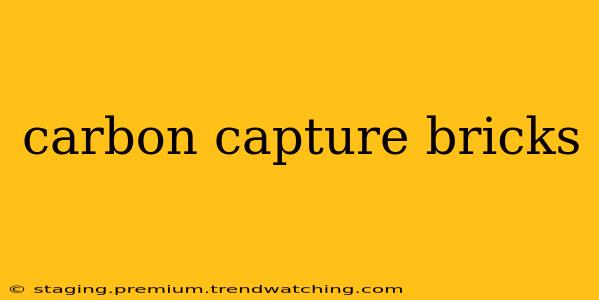The construction industry is a significant contributor to global carbon emissions. Cement production alone accounts for a substantial portion of these emissions. However, innovative solutions are emerging, and among them is the exciting prospect of carbon capture bricks. These bricks offer a potential pathway towards a more sustainable building future by incorporating captured CO2 into their composition. But how do they work, and are they truly a game-changer? Let's delve into the details.
How are Carbon Capture Bricks Made?
Several methods are being explored to create carbon capture bricks. One common approach involves using captured CO2 directly in the brick-making process. This can involve reacting the CO2 with other materials, such as calcium silicate, to form a solid carbonate compound that becomes part of the brick's structure. This effectively "locks" the CO2, preventing its release into the atmosphere. Other methods focus on utilizing by-products from industrial processes that already capture CO2, incorporating these into the brick mix to reduce waste and emissions simultaneously.
The exact process varies depending on the specific technology and materials used. Some techniques might involve high-temperature reactions, while others operate at lower temperatures, leading to variations in energy consumption and overall cost-effectiveness.
What are the Advantages of Using Carbon Capture Bricks?
The primary advantage of carbon capture bricks lies in their potential to significantly reduce the carbon footprint of the construction industry. By incorporating captured CO2, these bricks offer a pathway to creating a more environmentally friendly building material. Beyond the environmental benefits, there are other potential advantages:
- Improved Material Properties: In some cases, incorporating captured CO2 can actually enhance the strength and durability of the bricks, leading to a more robust and long-lasting building material.
- Waste Reduction: As mentioned, some methods utilize industrial by-products, contributing to waste reduction and a more circular economy.
- Potential for Carbon Negativity: If the energy used in the production of these bricks is sourced from renewable energy, the overall process could even become carbon negative, actively removing CO2 from the atmosphere.
Are Carbon Capture Bricks Cost-Effective?
Currently, the cost of producing carbon capture bricks is often higher than traditional bricks. The added complexity of the CO2 capture and incorporation process contributes to the increased expense. However, as the technology matures and scales up, economies of scale are expected to bring down the costs. Government incentives and subsidies aimed at promoting sustainable building practices could also play a significant role in making carbon capture bricks more economically viable.
What are the Environmental Impacts of Carbon Capture Bricks?
The environmental impact of carbon capture bricks is a complex issue with both positives and negatives. While the direct incorporation of CO2 is a clear positive, the energy required for production remains a crucial factor. The sourcing of this energy (renewable vs. fossil fuels) directly affects the overall carbon footprint. Lifecycle assessments, considering all stages from material extraction to end-of-life disposal, are vital for fully understanding the environmental benefits and challenges.
How Strong are Carbon Capture Bricks Compared to Traditional Bricks?
The strength of carbon capture bricks can vary depending on the specific manufacturing process and materials used. In some cases, studies suggest that the incorporation of captured CO2 can even lead to improved compressive strength compared to traditional bricks. However, it’s crucial to remember that this is not a universal outcome and will depend on the specific recipe and manufacturing method. Rigorous testing and standardization are essential to ensure the structural integrity and reliability of these innovative materials.
What is the Future of Carbon Capture Bricks?
The future of carbon capture bricks looks promising, albeit with challenges ahead. Continued research and development are essential to optimize production processes, reduce costs, and further enhance the properties of these innovative materials. Widespread adoption will also require supportive government policies, investment in infrastructure, and a shift in industry practices toward more sustainable building materials. As climate change concerns intensify, the demand for sustainable construction solutions like carbon capture bricks is likely to increase significantly. The development and implementation of carbon capture bricks represent a vital step towards a greener and more sustainable built environment.

